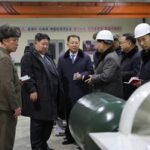The M65 Atomic Cannon: Was it ever fired?
Deployed in South Korea and West Germany

In the 1950s and 60s, just before the Cold War began in earnest, military strategists saw nuclear weapons as the perfect weapon to resolve all wars quickly. Thus, military engineers attempted to operate tactical nuclear weapons, i.e., nuclear weapons smaller in scale than atomic bombs. Looking back now, we may question the use of nuclear weapons on a tactical scale, but at the time, the limited understanding of their power and influence made it a viable challenge.
At that time, typical tactical nuclear weapons included nuclear suitcases, nuclear mines, nuclear bazookas, nuclear anti-aircraft guns, and the star of today’s story, the M65, a cannon that shoots atomic weapons. Let’s take a closer look at this weapon.


Borrowing the Concept of Long-Range Cannons
With a Cannon Caliber of 280mm
German engineers extended the cannon barrel’s length to achieve missile-class firing range in unusual ways, such as producing the Gustav Railway Gun during World War II. The United States designed the gigantic M65 self-propelled gun based on the Krupp K5 railway gun from Germany during World War II. Of course, unlike the Krupp gun, two special tractors could transport the M65.
In 1949, the U.S. Department of Defense commissioned the development of a gun capable of launching nuclear weapons at the Char Time Tini Arsenal. The arsenal then produced a 280mm maximum caliber cannon, the largest that could be manufactured then. The arsenal completed a launchable prototype in just three years, and all that remained was testing.


They Really Fired a Nuclear Warhead from a Cannon
But It Became Unnecessary
In 1953, in Nevada, the world’s only and last nuclear warhead cannon was fired. Just one 280mm shell caused an explosion comparable to the Little Boy bomb dropped on Hiroshima. The explosion was 15 kilotons, which seemed to secure the explosive power the U.S. wanted. The U.S. then deployed the M65 in front-line Cold War locations like West Germany and South Korea. Reports indicate that South Korea deployed four cannons.
However, the M65 quickly became obsolete. Not only did each unit of this weapon cost $800,000, but the development of nuclear warheads for 155mm and 8-inch howitzers and advancements in missile technology soon eliminated the need for using a short-range cannon to launch atomic weapons. Just over 10 years after its development, the military retired the M65 in 1963.


Soviet Union Also Developed Nuclear Cannons
The Inefficiency of Tactical Nuclear Weapons
As the Soviet Union and the United States were chasing each other, the Soviet Union also started developing a cannon capable of launching nuclear weapons upon hearing news of the M65’s development. The most notable are the 2A3 Kondensator and the 2B1 Oka. Although both cannons were huge, neither ever fired a nuclear weapon, and many say that firing a nuclear weapon would have likely eradicated the cannon.
These tactical nuclear weapons are not as effective as one might think. Neutralizing modern armored forces requires an overpressure of more than 50 psi. However, the overpressure of the M65’s nuclear shell, a 15kt atomic weapon, is only 10kt within 3.2km. There is a clear reason why major powers are obsessed with strategic nuclear weapons.















Most Commented